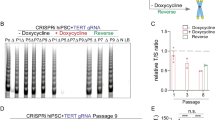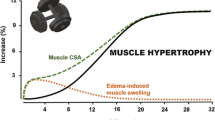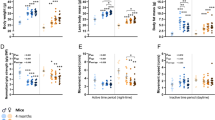Abstract
Muscle injuries are the most prevalent type of injury in sports. A great number of athletes have relapsed in muscle injuries not being treated properly. Photobiomodulation therapy is an inexpensive and safe technique with many benefits in muscle injury treatment. However, little has been explored about the infrared laser effects on DNA and telomeres in muscle injuries. Thus, the aim of this study was to evaluate photobiomodulation effects on mRNA relative levels from genes related to telomere and genomic stabilization in injured muscle. Wistar male rats were randomly divided into six groups: control, laser 25 mW, laser 75 mW, injury, injury laser 25 mW, and injury laser 75 mW. Photobiomodulation was performed with 904 nm, 3 J/cm2 at 25 or 75 mW. Cryoinjury was induced by two applications of a metal probe cooled in liquid nitrogen directly on the tibialis anterior muscle. After euthanasia, skeletal muscle samples were withdrawn and total RNA extracted for evaluation of mRNA levels from genomic (ATM and p53) and chromosome stabilization (TRF1 and TRF2) genes by real-time quantitative polymerization chain reaction. Data show that photobiomodulation reduces the mRNA levels from ATM and p53, as well reduces mRNA levels from TRF1 and TRF2 at 25 and 75 mW in injured skeletal muscle. In conclusion, photobiomodulation alters mRNA relative levels from genes related to genomic and telomere stabilization in injured skeletal muscle.





Similar content being viewed by others
References
Astur DC, Santos B, de Moraes ER, Arliani GG, Dos Santos PR, Pochini A de C (2015) Extracorporeal shockwave therapy to treat chronic muscle injury. Acta Ortop Bras 23:247–250. https://doi.org/10.1590/1413785220152305142211
Souza JD, Gottfried C (2013) Muscle injury: review of experimental models. J Electromyogr Kinesiol 23:1253–1260. https://doi.org/10.1016/j.jelekin.2013.07.009
Anders JJ, Lanzafame RJ, Arany PR (2015) Low-level light/laser therapy versus photobiomodulation therapy. Photomed Laser Surg 33:183–184. https://doi.org/10.1089/pho.2015.9848
Hamblin MR (2016) Photobiomodulation or low-level laser therapy. J Biophotonics 9:1122–1124. https://doi.org/10.1002/jbio.201670113
Hadis MA, Zainal SA, Holder MJ, Carroll JD, Cooper PR, Milward MR, Palin WM (2016) The dark art of light measurement: accurate radiometry for low-level light therapy. Lasers Med Sci 31:789–809. https://doi.org/10.1007/s10103-016-1914-y
Kuffler DP (2016) Photobiomodulation in promoting wound healing: a review. Regen Med 11:107–122. https://doi.org/10.2217/rme.15.82
Mesquita-Ferrari RA, Alves AN, de Oliveira Cardoso V, Artilheiro PP, Bussadori SK, Rocha LA, Nunes FD, Fernandes KP (2015) Low-level laser irradiation modulates cell viability and creatine kinase activity in C2C12 muscle cells during the differentiation process. Lasers Med Sci 30:2209–2213. https://doi.org/10.1007/s10103-015-1715-8
Alexsandra da Silva Neto Trajano L, da Silva CL, de Carvalho SN, Cortez E, Mencalha AL, de Souza da Fonseca A, Stumbo AC (2016) Cell viability, reactive oxygen species, apoptosis, and necrosis in myoblast cultures exposed to low-level infrared laser. Lasers Med Sci 31:841–848. https://doi.org/10.1007/s10103-016-1909-8
da Silva Neto Trajano LA, Stumbo AC, da Silva CL, Mencalha AL, Fonseca AS (2016) Low-level infrared laser modulates muscle repair and chromosome stabilization genes in myoblasts. Lasers Med Sci 31:1161–1167. https://doi.org/10.1007/s10103-016-1956-1
Assis L, Moretti AI, Abrahão TB, de Souza HP, Hamblin MR, Parizotto NA (2013) Low-level laser therapy (808 nm) contributes to muscle regeneration and prevents fibrosis in rat tibialis anterior muscle after cryolesion. Lasers Med Sci 28:947–955. https://doi.org/10.1007/s10103-012-1183-3
Ribeiro BG, Alves AN, Dos Santos LA, Cantero TM, Fernandes KP, Dias Dda S, Bernardes N, De Angelis K, Mesquita-Ferrari RA (2016) Red and infrared low-level laser therapy prior to injury with or without administration after injury modulate oxidative stress during the muscle repair process. PLoS One 11:e0153618. https://doi.org/10.1371/journal.pone.0153618
Alves AN, Ribeiro BG, Fernandes KP, Souza NH, Rocha LA, Nunes FD, Bussadori SK, Mesquita-Ferrari RA (2016) Comparative effects of low-level laser therapy pre- and post-injury on mRNA expression of MyoD, myogenin, and IL-6 during the skeletal muscle repair. Lasers Med Sci 31:679–685. https://doi.org/10.1007/s10103-016-1908-9
Rodrigues NC, Brunelli R, Abreu DC, Fernandes K, Parizotto NA, Renno AC (2014) Morphological aspects and Cox-2 expression after exposure to 780-nm laser therapy in injured skeletal muscle: an in vivo study. Braz J Phys Ther 18:395–401
Trajano LASN, Sergio LPS, Silva CL, Carvalho L, Mencalha AL, Stumbo AC, Fonseca AS (2016) Low-level laser irradiation alters mRNA expression from genes involved in DNA repair and genomic stabilization in myoblasts. Laser Phys Lett 13:075601. https://doi.org/10.1088/1612-2011/13/7/075601
Guedes de Almeida L, Sergio LPDS, de Paoli F, Mencalha AL, da Fonseca AS (2017) TP53 and ATM mRNA expression in skin and skeletal muscle after low-level laser exposure. J Cosmet Laser Ther 19:227–231. https://doi.org/10.1080/14764172.2017.1293829
Rice C, Skordalakes E (2016) Structure and function of the telomeric CST complex. Comput Struct Biotechnol J 14:161–167. https://doi.org/10.1016/j.csbj.2016.04.002
Deng W, Wu J, Wang F, Kanoh J, Dehe PM, Inoue H, Chen J, Lei M (2015) Fission yeast telomere-binding protein Taz1 is a functional but not a structural counterpart of human TRF1 and TRF2. Cell Res 25:881–884. https://doi.org/10.1038/cr.2015.76
Finzel A, Grybowski A, Strasen J, Cristiano E, Loewer A (2016) Hyperactivation of ATM upon DNA-PKcs inhibition modulates p53 dynamics and cell fate in response to DNA damage. Mol Biol Cell (15):2360–2367. https://doi.org/10.1091/mbc.E16-01-0032
Knittel G, Liedgens P, Reinhardt HC (2015) Targeting ATM-deficient CLL through interference with DNA repair pathways. Front Genet 10:207. https://doi.org/10.3389/fgene.2015.00207
Mao A, Liu Y, Zhang H, Di C, Sun C (2014) microRNA expression and biogenesis in cellular response to ionizing radiation. DNA Cell Biol 33:667–679. https://doi.org/10.1089/dna.2014.2401
Karlseder J, Hoke K, Mirzoeva OK, Bakkenist C, Kastan MB, Petrini JH, de Lange T (2004) The telomeric protein TRF2 binds the ATM kinase and can inhibit the ATM-dependent DNA damage response. PLoS Biol 2:E240
Livak KJ, Schmittgen TD (2001) Analysis of relative gene expression data using real-time quantitative PCR and the 2(−Delta Delta C(T)). Method Methods 25:402–408
Arany PR (2016) Craniofacial wound healing with photobiomodulation therapy: new insights and current challenges. J Dent Res 95:977–984. https://doi.org/10.1177/0022034516648939
Yadav A, Gupta A (2017) Noninvasive red and near-infrared wavelength-induced photobiomodulation: promoting impaired cutaneous wound healing. Photodermatol Photoimmunol Photomed 33:4–13. https://doi.org/10.1111/phpp.12282
Hamblin MR (2018) Photobiomodulation for traumatic brain injury and stroke. J Neurosci Res 96:731–743. https://doi.org/10.1002/jnr.24190
de Brito A, Alves AN, Ribeiro BG, Barbosa DVDE, Magalhaes EMR, Fernandes KPS, Bussadori SK, Goulardins JB, Mesquita-Ferrari RA (2018) Effect of photobiomodulation on connective tissue remodeling and regeneration of skeletal muscle in elderly rats. Lasers Med Sci 33:513–521. https://doi.org/10.1007/s10103-017-2392-6
Trajano LADSN, Sergio LPDS, Stumbo AC, Mencalha AL, Fonseca ASD (2018) Low power lasers on genomic stability. J Photochem Photobiol B 180:186–197. https://doi.org/10.1016/j.jphotobiol.2018.02.010
Ho-Pun-Cheung A, Bascoul-Mollevi C, Assenat E, Boissière-Michot F, Bibeau F, Cellier D, Ychou M, Lopez-Crapez E (2009) Reverse transcription-quantitative polymerase chain reaction: description of a RIN-based algorithm for accurate data normalization. BMC Mol Biol 10:31. https://doi.org/10.1186/1471-2199-10-31
Canuto KS, Sergio LPS, Paoli F, Mencalha AL, Fonseca AS (2016) Low-level lasers affect uncoupling protein gene expression in skin and skeletal muscle tissues. Laser Phys 26:035601
Sergio LP, Campos VM, Vicentini SC, Mencalha AL, de Paoli F, Fonseca AS (2016) Low-intensity red and infrared lasers affect mRNA expression of DNA nucleotide excision repair in skin and muscle tissue. Lasers Med Sci 31:429–435. https://doi.org/10.1007/s10103-016-1870-6
Canuto KS, Teixeira AF, Rodrigues JA, Paoli F, Nogueira EM, Mencalha AL, Fonseca AS (2017) Low-level lasers on microRNA and uncoupling protein 2 mRNA levels in human breast cancer cells. Laser Phys 27:065601
Laye MJ, Solomon TP, Karstoft K, Pedersen KK, Nielsen SD, Pedersen BK (2012) Increased shelterin mRNA expression in peripheral blood mononuclear cells and skeletal muscle following an ultra-long-distance running event. J Appl Physiol 112:773–781. https://doi.org/10.1152/japplphysiol.00997.2011
Ludlow AT, Spangenburg EE, Chin ER, Cheng WH, Roth SM (2014) Telomeres shorten in response to oxidative stress in mouse skeletal muscle fibers. J Gerontol A Biol Sci Med Sci 69:821–830. https://doi.org/10.1093/gerona/glt211
Yang ZJ, Broz DK, Noderer WL, Ferreira JP, Overton KW, Spencer SL, Meyer T, Tapscott SJ, Attardi LD, Wang CL (2015) p53 suppresses muscle differentiation at the myogenin step in response to genotoxic stress. Cell Death Differ 22:560–573. https://doi.org/10.1038/cdd.2014.189
Mendoza M, Mandani G, Momand J (2014) The MDM2 gene family. Biomol Concepts 5:9–19. https://doi.org/10.1515/bmc-2013-0027
Meng X, Franklin DA, Dong J, Zhang Y (2014) MDM2-p53 pathway in hepatocellular carcinoma. Cancer Res 15:7161–7167. https://doi.org/10.1158/0008-5472.CAN-14-1446
Mirzayans R, Andrais B, Scott A, Murray D (2012) New insights into p53 signaling and cancer cell response to DNA damage: implications for cancer therapy. J Biomed Biotechnol 2012:170325. https://doi.org/10.1155/2012/170325
Carroll B, Donaldson JC, Obeid L (2015) Sphingolipids in the DNA damage response. Adv Biol Regul 58:38–52. https://doi.org/10.1016/j.jbior.2014.11.001
Ribeiro CJ, Rodrigues CM, Moreira R, Santos MM (2016) Chemical variations on the p53 reactivation theme. Pharmaceuticals (Basel) 9. https://doi.org/10.3390/ph9020025
Zhang P, Dilley C, Mattson MP (2007) DNA damage responses in neural cells: focus on the telomere. Neuroscience 145:1439–1448
Pal D, Sharma U, Singh SK, Kakkar N, Prasad R (2015) Over-expression of telomere binding factors (TRF1 & TRF2) in renal cell carcinoma and their inhibition by using SiRNA induce apoptosis, reduce cell proliferation and migration in vitro. PLoS One 10:e0115651. https://doi.org/10.1371/journal.pone.0115651
Galati A, Micheli E, Alicata C, Ingegnere T, Cicconi A, Pusch MC, Giraud-Panis MJ, Gilson E, Cacchione S (2015) TRF1 and TRF2 binding to telomeres is modulated by nucleosomal organization. Nucleic Acids Res 43:5824–5837. https://doi.org/10.1093/nar/gkv507
Patel TN, Vasan R, Gupta D, Patel J, Trivedi M (2015) Shelterin proteins and cancer. Asian Pac J Cancer Prev 16:3085–3090
Diotti R, Loayza D (2011) Shelterin complex and associated factors at human telomeres. Nucleus 2:119–135. https://doi.org/10.4161/nucl.2.2.15135
Karlseder J, Smogorzewska A, de Lange T (2002) Senescence induced by altered telomere state, not telomere loss. Science 295:2446–2449
Trajano ET, Mencalha AL, Monte-Alto-Costa A, Pôrto LC, de Souza da Fonseca A (2014) Expression of DNA repair genes in burned skin exposed to low-level red laser. Lasers Med Sci 29:1953–1957. https://doi.org/10.1007/s10103-014-1612-6
Sergio LP, Silva AP, Amorim PF, Campos VM, Magalhães LA, de Paoli F, de Souza da Fonseca A (2015) DNA damage in blood cells exposed to low-level lasers. Lasers Surg Med 47:361–368. https://doi.org/10.1002/lsm.22344
Role of funding source
This work was supported by Fundação de Amparo à Pesquisa do Estado do Rio de Janeiro (FAPERJ) and Conselho Nacional de Pesquisa (CNPq).
Author information
Authors and Affiliations
Corresponding author
Ethics declarations
Conflict of interest
The authors declare that they have no conflict of interest.
Ethical approval
This study received Universidade do Estado do Rio de Janeiro Research Ethics Committee’s approval, process number CEUA/024/2014.
Informed consent
Informed consent is not necessary to this study.
Rights and permissions
About this article
Cite this article
da Silva Neto Trajano, L.A., Trajano, E.T.L., da Silva Sergio, L.P. et al. Photobiomodulation effects on mRNA levels from genomic and chromosome stabilization genes in injured muscle. Lasers Med Sci 33, 1513–1519 (2018). https://doi.org/10.1007/s10103-018-2510-0
Received:
Accepted:
Published:
Issue Date:
DOI: https://doi.org/10.1007/s10103-018-2510-0




